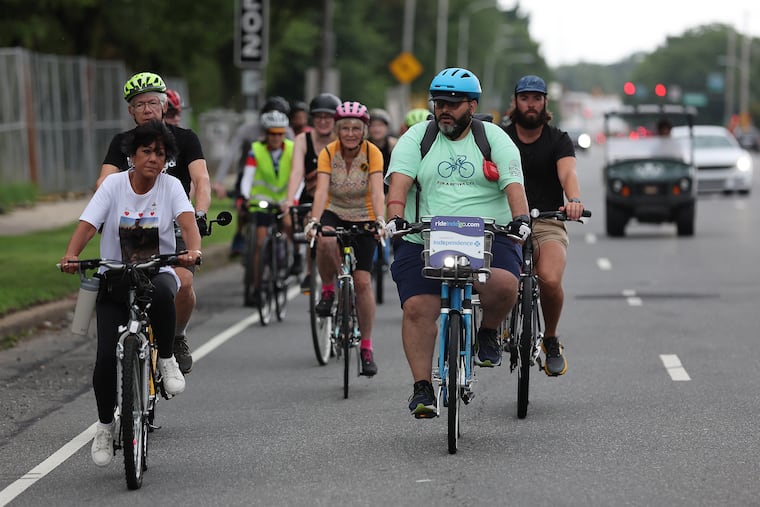Concrete barriers are the only way to really protect cyclists in the Spruce and Pine bike lanes
If Hoboken can achieve zero traffic fatalities, why can’t Philadelphia?

Imagine your neighbor had a chance to save your life.
Now, imagine they decided your life wasn’t worth losing their temporary parking spot.
It’s an unthinkable decision, and yet, if a handful of our Center City neighbors get their way, Barbara Friedes and Emily Fredricks will be far from the last victims of traffic violence in the bike lanes along Spruce and Pine Streets.
In the last month, the Center City Residents Association and the Society Hill Civic Association both passed motions to oppose the city’s plans to make these streets safer. They want a “carve out” from the Get Out the Bike Lane bill — a new law passed unanimously by City Council and signed by Mayor Cherelle L. Parker — which prohibits vehicles from stopping in bike lanes citywide. The neighborhood groups also want to prevent the installation of protective concrete curb separators on the Spruce and Pine bike lanes.
Critics of the new law argue that the status quo of a bike lane full of cars is a better solution than decades of research and evidence that proves physically separated bike lanes lead to less speeding by motorists, fewer injuries to all road users, better sales for businesses, and more appealing communities for all.
Separating the bike lane from the car lane would involve a few specific interventions:
Low concrete dividers, similar to ones used to stop parked cars from rolling forward.
Concrete planters at intersections that are not dissimilar to the planters used throughout Center City to keep pedestrians on the sidewalks safe from cars.
Increasing the number of loading zones along Spruce and Pine to give businesses places to receive deliveries, and ride-share drivers spaces to drop off passengers.
Strategies like these have been implemented in several densely populated cities, including Pittsburgh, Washington, D.C., and, most importantly, Hoboken, N.J. Hoboken has gone seven years without a traffic fatality — partly by implementing inexpensive changes like separated bike lanes — in a city that looks a lot like Philadelphia. The Mile Square City shares our narrow streets, brick rowhouses, and cozy cafés and bars.
It begs the question: If Hoboken can achieve zero traffic fatalities, why can’t Philadelphia?
Urban planners speak of the “ice cream test”: Can an 8-year-old safely get somewhere to buy an ice cream and get home before it melts?
No rational parent would let their 8-year-old use the Spruce and Pine bike lanes to get an ice cream today, yet some of our neighbors insist that the status quo is safe enough — and that their ad hoc parking spot is more important than our children, our doctors, our friends, and any other neighbor on a bike in Philly.
Philadelphia was not built for the car. It wasn’t even built for the horse and buggy. Philadelphia was built for human beings on foot, and pedestrian accessibility is one of our great civic advantages in a nation that increasingly seems to be focused on building around strip malls and massive suburban highways.
Since the early 1900s, the city has tried to carve up more and more of itself for cars, with only gridlock and some of the deadliest streets in America to show for it. (From 2014 to 2023, Philadelphia recorded an average of 104 traffic-related fatalities each year; the rate of traffic deaths here is three times higher than in New York City.)
The city’s plan to protect the Spruce and Pine bike lanes represents a major step toward correcting this problem and could herald all manner of safety improvements.
Nearly 47,500 people use the Spruce and Pine bike lanes each month, and petition after petition demonstrates support for a protected bike lane.
The city has tried to carve up more and more of itself for cars with only gridlock and some of the deadliest streets in America to show for it.
I have spoken to residents, business owners, and everyday people who live, work, and shop along the corridor. The vast majority are in support of the city’s protection plans, and many can tell you tales of horrific crashes and driver violence they witness every day on Spruce and Pine. They all want to see safer streets, and many bike to work or for transport.
It is imperative that these changes factor in all Philadelphians. I gave testimony to City Council last year alongside advocates with disabilities who also support the changes (many disabled Philadelphians use bike lanes as a smoother, obstacle-free alternative to sidewalks).
The city should ensure that the changes to the lanes protect cyclists and people with mobility devices while not acting as an undue obstruction to those with mobility challenges, both inside and outside the bike lane.
Philadelphia is one of the few American cities that has maintained its compact urban form through the age of the automobile. Where other U.S. cities demolished their downtowns to fit in highways and parking lots, Philadelphians successfully fought off the destruction of our urban core.
This is an asset that led us to be named the most walkable city in America. Protecting the bike lane will give people a comfortable new way to get around town, make our streets safer, and reduce traffic for people who do need to drive.
With time, Philly could also get named the most bikeable city in America — all we have to do is protect our bike lanes so that cyclists are truly safe from cars.
Duncan Adkins is a member of Philly Bike Action and Center City Residents Association.